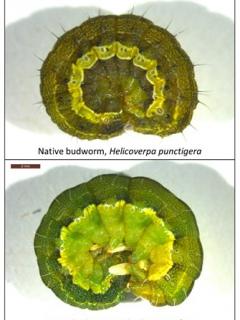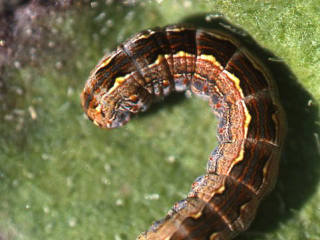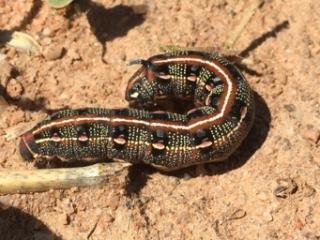Caterpillar pests – how to recognise them in your crop
- Geraldton
Recently Peter Eliott-Lockhart (Elders) has reported cabbage centre grubs being present on canola seedlings at Geraldton.
Early identification of caterpillar pests is important to prevent further damage to emerging crops. Caterpillars can be tricky to correctly identify, especially when they are small, due to their similarities in appearance. Fortunately, growers and consultants can request or confirm identification of potential broadacre insect pests by contacting the PestFacts WA team at pestfactswa@dpird.wa.gov.au.
Caterpillar pests that growers should be aware of on emerging crops include the brown pasture looper, cutworm, webworm, weed web moth, cabbage centre grub and pasture day moth.
Native budworm may be present at this time of year on volunteer lupins, canola, clovers and weeds, but is rarely a problem early in the season. Hawk moth caterpillars are commonly encountered, although they are very rarely seen damaging crops and feed on weeds such as tar vine.
Brown pasture looper
These caterpillars are slender grey or brown with distinctive cream or yellow stripes that appear after they reach 10 mm in length. Young caterpillars can be seen on plant leaves during the day and move with a characteristic looping motion. When the caterpillars reach full size at 30 mm long, they cease the looping motion. For more information refer to DPIRD’s Diagnosing brown pasture looper page.
Cutworm
Cutworm caterpillars can grow to 50 mm in length and appear plump, with a hairless body and dark head. There are several species of cutworm pests:
- Caterpillars with a pink tinge are Agrotis munda
- Dark grey caterpillars are bogong moth Agrotis infusa
- Patterned caterpillars are Rictonis spp. and Omphaletis spp.
Cutworm feed on leaves and stems at ground level, and hide in the soil during the day, often at the base of lopped plants. It is common to see patches within a crop where plants have had leaves lopped or stems cut at the base. For more information refer to DPIRD’s Diagnosing cutworm in cereals and Cutworm: pests of crops and pastures pages.
Weed web moths and cabbage centre grubs

These caterpillar species can look very similar, and both have brown banding along the body. The weed web moth has characteristic dark circles or spots along the body. Both species produce webbing amongst the leaf tissue, providing them some protection from chemical sprays.
Cabbage centre grub and weed web moth are minor early establishment pests that rarely reach high enough numbers to cause economic damage. However, weed web moth can be problematic in warmer than average years with early autumn rainfall. For more information refer to DPIRD’s 2020 PestFax Issue 2 article Caterpillars continue to cause concern.
Webworm
Webworm caterpillars are leaf-chewing pests of seedling wheat and barley and are light brown in colour with black heads and grow to 15 mm long. During the day they hide in web-lined tunnels. These caterpillars typically sever the oldest leaves at ground level and pull them into web-lined holes near the plants. For information refer to DPIRD’s Diagnosing webworm page.
Pasture day moth
Pasture day moth is an occasional pest of canola plants, although it feeds mainly on broadleaf pasture species and weeds. The caterpillars can grow to 50 mm in length and are dark brown with yellow and reddish-orange markings. They have two prominent yellow spots near the end of their body and an orange-black head. For more information refer to DPIRD’s Diagnosing pasture day moth damage page.
Native budworm and lesser budworm

Native budworm is a major pest of pulse and canola crops and can cause serious yield loss to canola as pods mature. At this time of year, they may be found feeding on volunteer lupins, clovers and weeds and transfer onto new crops. For more information refer to DPIRD’s Management and economic thresholds for native budworm page.
Native budworm is closely related to the lesser budworm, and caterpillars look very similar. Both can vary in colour from light to dark greens and have a light-coloured strip down each side of the body. For older larvae (more than 20 mm in length), lesser budworm has white hairs on the collar (segment behind the head) and the body, while native budworm has black hairs on the collar and black to blackish-brown body hairs.
Hawk moth caterpillars
Young hawk moth caterpillars are green with a dark dorsal line ending in a stumpy black tail spike, but final instar caterpillars may be green, brown, or black. The tail spike becomes strongly curved backwards. Their known hosts are lucerne and multiple weed species including hogweed, tar vine and pigweed.
Managing caterpillars and considering beneficials
Growers are advised to monitor their paddocks for caterpillar activity and spray only if they are present and feeding on the crop.
If numbers warrant spraying then growers and consultants can refer to DPIRD’s 2024 autumn winter insecticide guide.
Growers should consider insecticide options that are soft on predator insects if spraying.
For more information on beneficials refer to DPIRD’s Know what beneficials look like in your crop page.
Further information
The PestFacts WA Reporter app is temporarily unavailable. You can request or confirm identification of potential broadacre insect pests by emailing the PestFacts WA team at pestfactswa@dpird.wa.gov.au or by contacting one of the following DPIRD Research Scientists Svetlana Micic in Albany on +61 (0)8 9892 859, Andrew Phillips in Geraldton on +61 8 9956 8567 or Dusty Severtson in Northam on +61 8 9690 2160.
Article author: Bec Severtson (DPIRD Northam).






